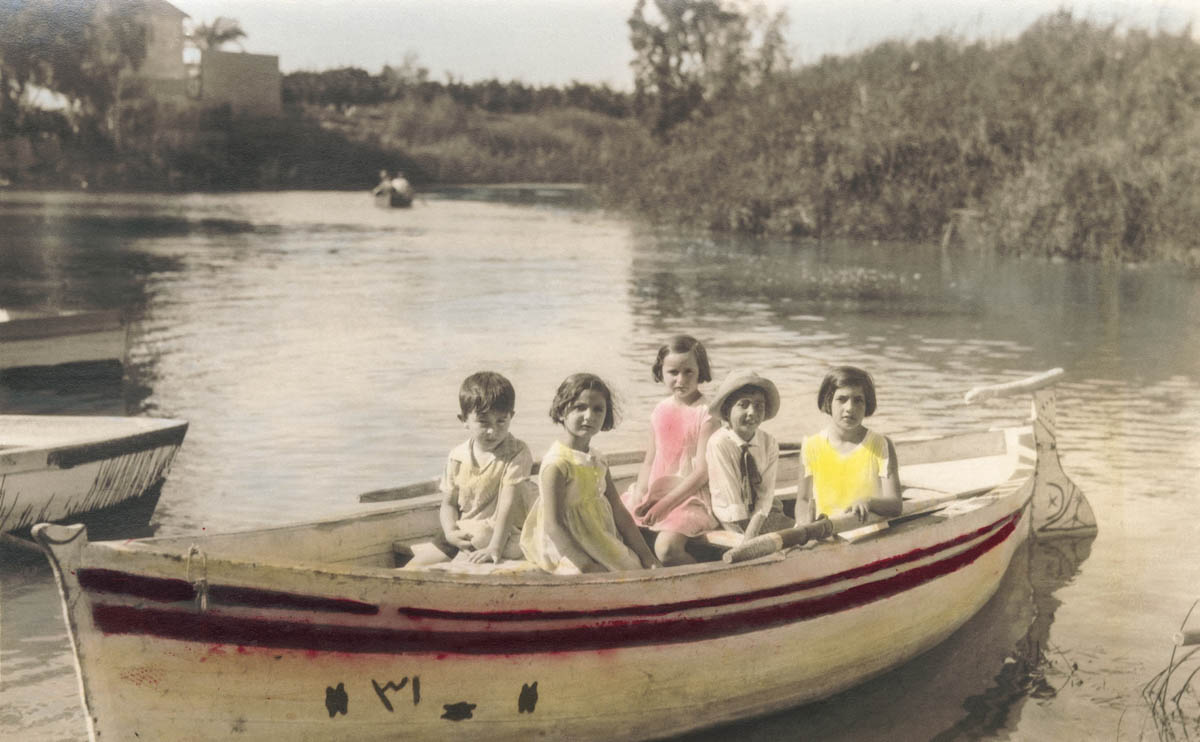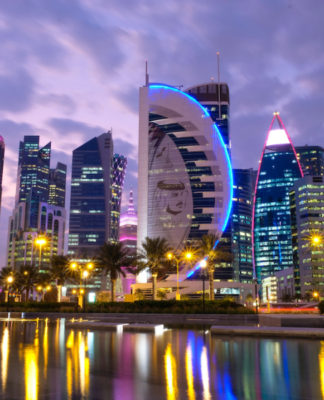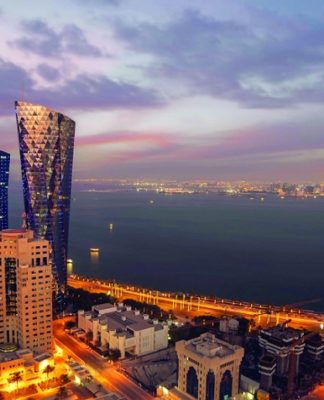![Aida, Elsie and Raymond Krikorian with Ruth and Georges Raad, al-Auja, Palestine, 1931. [Aida Krikorian Kawar/Arab Image Foundation]](https://www.aljazeera.com/mritems/Images/2017/12/11/8ad7efcb606b44cda2cdf43b57234804_8.jpg)
Dressed in a white t-shirt and raised on another protester’s shoulders, a man in Lebanon joins a demonstration in support of Egyptian President Gamal Abdel Nasser in 1956, just two years before Lebanon’s first civil war in 1958.
In 1970, a brand new hospital in Qatar sits in a lonely spot, no traffic interrupting the road ahead.
A group of boys take a school trip in Kuwait to al-Fintas in 1950, accompanied by smartly dressed teachers.
And two of the Arab world’s most celebrated performers are seen in a movie still, with Egyptian Samia Gamal watching over Syrian Farid el-Atrash as he fixes a car with the pyramids in the near distance.
These are just some of the 15 images on show in this gallery, a taste of Middle Eastern history in its rich tapestry.
As one of the most prominent cultural institutions in the Middle East, the Arab Image Foundation (AIF) has led the way in the collection, preservation and study of photographs from the region.
Established in Beirut, Lebanon, in 1997, AIF has spent 20 years contributing to a greater cultural, political and social understanding of the Middle East.
Today, it holds hundreds of thousands of images from not only its home country but also the likes of Iraq, Jordan, Palestine, Syria and Tunisia, as well as the wider Arab diaspora.
“In 1997, the AIF embarked on an ambitious project to collect samples from the work of photographers in the Middle East with the aim of writing the history of a practice that hadn’t been told prior to this date,” Akram Zaatari, AIF co-founder, told Al Jazeera.
Many in the region didn’t then consider photographs “worth keeping unless for the emotional ties to the subjects in it”,” said Zaatari, a Lebanese photographer and filmmaker.
“When we started the AIF, we insisted on writing the history of this practice because we wanted to research what photographers’ daily work was like. We were interested how they worked, what material they used, how they made aesthetic choices and who taught them.
“The AIF is today the only register in this part of the world that keeps samples of work from a large slice of photo-practitioners from the 20th century.”
Home to a vast array of images, negatives and other photographic material from the mid-19th century to the present day, AIF presents as a modern outfit.
Led by its 30-year-old director, Marc Mouarkech, the organisation has adopted a highly developed approach to its prized possessions.
Individual items, for example, are routinely referred to as “objects” by AIF staff, not images or photographs, to reflect the dynamic and multi-layered nature of each artefact.
“Today, we have 600,000 objects that are divided into 301 collections,” Mouarkech told Al Jazeera. “We don’t consider that we have just one collection, but rather 301 different collections with different morphologies and different specificities.”
Despite receiving no public funds, AIF is first and foremost a “public institution” with an “educational and patrimonial role”, said Mouarkech.
In April 2018, for instance, the organisation will launch an online platform with the aim of engaging with the public to gather more information about little-known objects.
During the same month, it will re-open its doors to visitors after a period of closure to outsiders.
To mark 20 years of AIF, this is a brief visual celebration of the Arab world as caught on film by some of the region’s most prolific photographers.
Reporting by Alasdair Soussi.












![Dressed in a white t-shirt and raised on another protester's shoulders, a man in the Lebanese city of Saida joins a public demonstration in support of Egyptian President Gamal Abdel Nasser in 1956. [Chafic El-Soussi/Arab Image Foundation]](https://www.aljazeera.com/mritems/Images/2017/12/11/929641fabc224529b02f7fd6d08a2830_8.jpg)
![Elias Mirshak's trip to Sudan - Natives in front of a hut, Sudan, 1944. [Emma Fahoum/Arab Image Foundation]](https://www.aljazeera.com/mritems/Images/2017/12/11/89d4e5c3cd434a39a90711e7f85eb70f_8.jpg)
![Qattina lake, Talkalakh, Syria, 1960. [FAI/Arab Image Foundation]](https://www.aljazeera.com/mritems/Images/2017/12/11/6a44b22d0c3d4fa892ecb36de31288d9_8.jpg)
![Farid el-Atrash and Samia Gamal, Cairo, Egypt. [Faysal El-Atrash/Arab Image Foundation]](https://www.aljazeera.com/mritems/Images/2017/12/11/41fe1ef5bd3f4c50998b36867db5532c_8.jpg)
![View of the Yarmouk river, on Jordan's northeastern border with Syria, Mukhaibeh, Jordan. [Bakerdjian/Arab Image Foundation]](https://www.aljazeera.com/mritems/Images/2017/12/11/95a287701685446ebf2d0405f0dc1210_8.jpg)
![In the desert between 'Beit el Hollat' and 'El Moussaiab', on the road to Iraq, 1939. [Zuhair Izzat Darwazeh/Arab Image Foundation]](https://www.aljazeera.com/mritems/Images/2017/12/11/9e6d04bb2f65448db6faeaa0e8784206_8.jpg)
![A street in Manama on Bahrein Island, Persian Gulf, Manama, Bahrain, 1950. [ACS/Arab Image Foundation]](https://www.aljazeera.com/mritems/Images/2017/12/11/d27dff389424469b87cdb6abf866da05_8.jpg)
![Artisan wells, Qatif, Saudi Arabia, 1950. [ACS/Arab Image Foundation]](https://www.aljazeera.com/mritems/Images/2017/12/11/40f17f6ed71b470d8f97bdb927cc3960_8.jpg)
![Gardens of Maktar, Tunisia. [Jacqueline Alluchon/Arab Image Foundation]](https://www.aljazeera.com/mritems/Images/2017/12/11/4d3a408adccc4b6bba0675a74eaf7daf_8.jpg)
![School outing to al-Fintas, Kuwait, 1950. [Abdel Razzak Badran/Arab Image Foundation]](https://www.aljazeera.com/mritems/Images/2017/12/11/d25af74589fd4d1aa87d4d474080ce7b_8.jpg)
![Carrier walking down the street of a village, Algeria. [Arnaud de Boistesselin/Arab Image Foundation]](https://www.aljazeera.com/mritems/Images/2017/12/11/84f74cabd7a94a1880264c0f36b088a5_8.jpg)
![Hamad General Hospital, Qatar, 1970. [Jorge Abud Chami/Arab Image Foundation]](https://www.aljazeera.com/mritems/Images/2017/12/11/a48ef33c0e554c0b9e0d2ed0644095a4_8.jpg)
![Aerial view of the city of Abu Dhabi, United Arab Emirates, 1960. [Jorge Abud Chami/Arab Image Foundation]](https://www.aljazeera.com/mritems/Images/2017/12/11/4baf2e083fff417e9d7d0b7e03800fb8_8.jpg)














